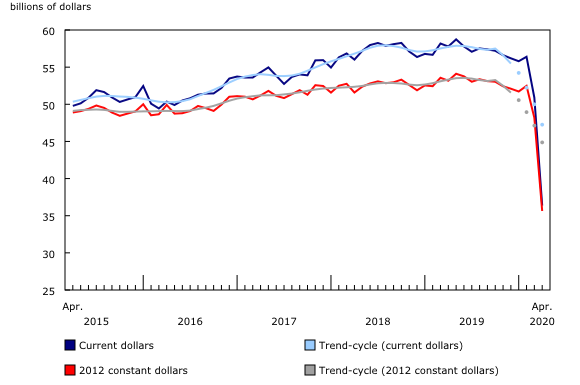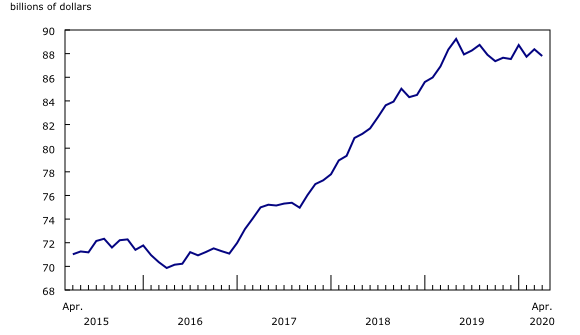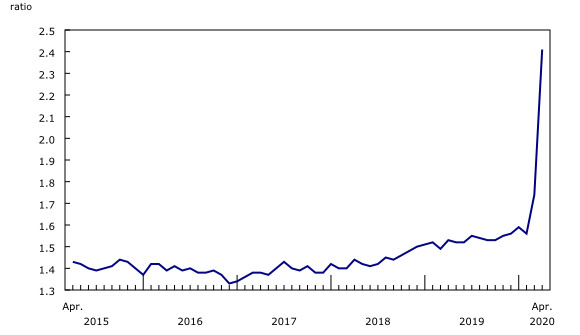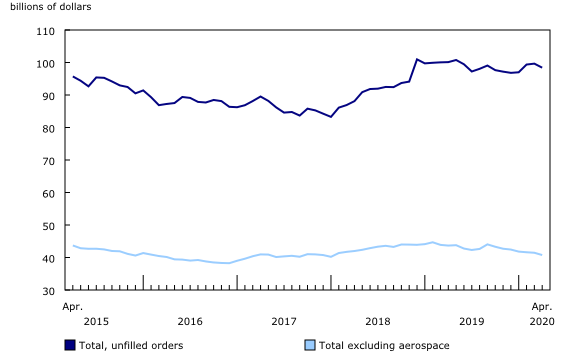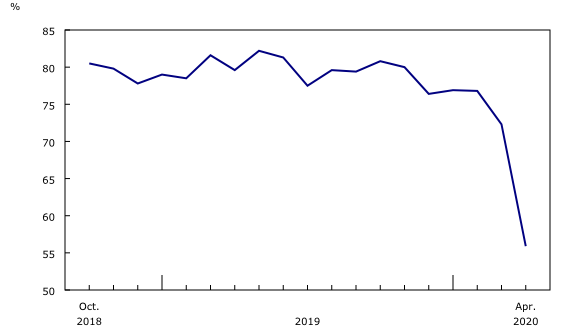Monthly Survey of Manufacturing, April 2020
Archived Content
Information identified as archived is provided for reference, research or recordkeeping purposes. It is not subject to the Government of Canada Web Standards and has not been altered or updated since it was archived. Please "contact us" to request a format other than those available.
Released: 2020-06-15
Manufacturing sales fell by a record 28.5% to $36.4 billion in April, following a 9.8% decline in March. April marked the first full month of physical distancing measures in the wake of COVID-19 and manufacturing plants operated at limited capacity or ceased operations completely.
Sales were down in all 21 industries, led by sharp declines in the transportation equipment and petroleum and coal product industries.
In volume terms, manufacturing sales fell by a record 26.0%, indicating that a much lower volume of products was sold in April.
Over four-fifths of manufacturers report that COVID-19 impacted their operations
Feedback from respondents highlighted the impact of the COVID-19 pandemic on sales in April.
Over four-fifths (85.2%) of establishments in the manufacturing sector reported that their activities were impacted by COVID-19. Manufacturers in the printing and related product (95.6%), furniture and related product (93.7%), transportation equipment (93.7%), textile mills (92.0%), computer and electronic product (91.6%) and clothing (91.0%) industries reported operating at limited capacity or ceased operations completely in response to lower global demand or to comply with physical distancing measures.
Based on respondent feedback, the largest estimated impacts of COVID-19 on manufacturing sales in dollar terms were in the transportation equipment (-$4.9 billion), petroleum and coal product (-$1.6 billion), fabricated metal product (-$844 million), plastic and rubber product (-$831 million), food (-$811 million), machinery (-$783 million) and primary metal (-$710 million) industries. Note that these estimated impacts are on an unadjusted basis. However, they provide an estimate of the magnitude to which COVID-19 may have lowered sales.
Decline in April largely attributable to transportation equipment and petroleum and coal product industries
Sales in the transportation equipment industry fell by over three-quarters (-76.4%) to $1.9 billion in April, the largest decrease on record. This drop was led by sharp declines in the motor vehicle (-97.5%) and motor vehicle parts (-88.1%) industries. Every Canadian assembly plant ceased operations in April, while many motor vehicle parts suppliers in North America operated at limited capacity or closed operations completely.
Sales declined for the fourth consecutive month in the petroleum and coal product industry, falling by a record 46.4% to $2.0 billion in April. The drop reflected lower prices and sales, as refineries curtailed production in response to reduced demand for energy products in April. The lower demand was due to an increase in remote work and a decline in commuting, which lowered energy consumption.
Sales in the food industry fell 12.8% to $8.7 billion in April, following a 9.9% gain in March. The declines in April were widespread, but were most pronounced in the meat and dairy industries. Many meat processing plants shut down after some employees tested positive for COVID-19. Dairy manufacturers were affected by the shutdown of non-essential services such as restaurants, hotels and schools.
Large declines were also reported by the fabricated metal product (-26.1%), plastic and rubber (-31.0%), primary metal (-16.4%), machinery (-16.4%) and wood product (-19.0%) industries. Some plants across the country temporarily ceased operations in the wake of physical distancing measures. Sales declines also reflected fewer or postponed orders from clients due to uncertainty about the global economy.
Sales down in every province
Manufacturing sales were down in every province in April. However, Ontario and Quebec accounted for over four-fifths (-81.0%) of the national decline.
Manufacturing sales in Ontario fell by a record 37.1% to $14.0 billion. Sales declined in all 21 industries, led by the motor vehicle (-98.9%), motor vehicle parts (-90.6%), primary metal (-32.0%) petroleum and coal product (-47.7%), food (-10.8%) and plastic and rubber product (-34.9%) industries.
Sales were down in Quebec for the third consecutive month, falling by a record 26.7% to $9.6 billion in April. Sales were down in all 21 industries, led by the transportation equipment, food, and petroleum and coal product industries.
Inventory levels decrease
Inventory levels decreased 0.6% to $87.8 billion in April, following a 0.7% increase in March. Inventories were down in 12 of 21 industries, led by the petroleum and coal product industry (-18.8%). This decline was partly offset by higher inventories in the transportation equipment (+1.3%), primary metal (+1.7%) and food (+0.9%) industries.
The inventory-to-sales ratio jumped from 1.74 in March to 2.41 in April, mostly due to lower sales. This was the largest monthly increase in the inventory-to-sales ratio since December 2008. This ratio measures the time, in months, that would be required to exhaust inventories if sales were to remain at their current level.
Unfilled orders decline
Estimates of the unfilled orders were revised upwards to $99.4 billion in February, reflecting new information received from respondents.
Unfilled orders decreased 1.2% to $98.4 billion in April from a revised $99.6 billion in March. The decrease was mainly attributable to lower unfilled orders in the transportation equipment (-1.1%) and primary metal (-17.2%) industries.
New orders fell by almost one-third (-31.3%) to $35.1 billion in April, mostly reflecting lower new orders in the transportation equipment (-85.9%) and the petroleum and coal product (-46.3%) industries.
Capacity utilization rate falls
The unadjusted capacity utilization rate for the manufacturing sector declined 16.4 percentage points to 55.9% in April—the lowest rate since the series began in January 2017.
The capacity utilization rate for durable goods (down 23.5 percentage points to 45.4%) and non-durable goods (down 7.9 percentage points to 68.6%) manufacturing also fell to record lows on broad-based declines.
Looking forward: Impacts of COVID-19 on manufacturing sector in May 2020
Statistics Canada remains committed to providing an accurate picture of the social and economic impacts of COVID-19.
During the second week of May, many manufacturers resumed production after full or partial shutdowns in April. Provinces and territories started a phased reopening of non-essential businesses in May, by easing restrictions on capacity (number of customers), or by requiring mask-wearing where physical distancing is not possible, which is expected to bolster sales compared with April.
Sustainable Development Goals
On January 1, 2016, the world officially began implementation of the 2030 Agenda for Sustainable Development — the United Nations' transformative plan of action that addresses urgent global challenges over the next 15 years. The plan is based on 17 specific sustainable development goals.
The Monthly Survey of Manufacturing is an example of how Statistics Canada supports the reporting on the Global Goals for Sustainable Development. This release will be used in helping to measure the following goal:

Note to readers
While the quality of this month's data remains high, response rates from manufacturers have fallen from the usual 95% to a rate of 87% in April. Every effort has been made to supplement this month's data with information from other sources.
Monthly data in this release are seasonally adjusted and are expressed in current dollars unless otherwise specified.
Seasonally adjusted data are data that have been modified to eliminate the effect of seasonal and calendar influences to allow for more meaningful comparisons of economic conditions from period to period. For more information on seasonal adjustment, see Seasonally adjusted data – Frequently asked questions.
Trend-cycle estimates are included in selected charts as a complement to the seasonally adjusted series. These data represent a smoothed version of the seasonally adjusted time series and provide information on longer-term movements including changes in direction underlying the series. For information on trend-cycle data, see Trend-cycle estimates – Frequently asked questions.
Both seasonally adjusted data and trend-cycle estimates are subject to revision as additional observations become available. These revisions could be large and could even lead to a reversal of movement, especially for reference months near the end of the series or during periods of economic disruptions.
Non-durable goods industries include food, beverage and tobacco products, textile mills, textile product mills, clothing, leather and allied products, paper, printing and related support activities, petroleum and coal products, chemicals, and plastics and rubber products.
Durable goods industries include wood products, non-metallic mineral products, primary metals, fabricated metal products, machinery, computer and electronic products, electrical equipment, appliances and components, transportation equipment, furniture and related products, and miscellaneous manufacturing.
Production-based industries
For the aerospace and shipbuilding industries, the value of production is used instead of the value of sales of goods manufactured. The value of production is calculated by adjusting monthly sales of goods manufactured by the monthly change in inventories of goods in process and finished products manufactured. The value of production is used because of the extended period of time that it normally takes to manufacture products in these industries.
Unfilled orders are a stock of orders that will contribute to future sales assuming that the orders are not cancelled.
New orders are those received, whether sold in the current month or not. New orders are measured as the sum of sales for the current month plus the change in unfilled orders from the previous month to the current month.
Manufacturers reporting sales, inventories and unfilled orders in US dollars
Some Canadian manufacturers report sales, inventories and unfilled orders in US dollars. These data are then converted to Canadian dollars as part of the data production cycle.
For sales, based on the assumption that they occur throughout the month, the average monthly exchange rate for the reference month established by the Bank of Canada is used for the conversion. The monthly average exchange rate is available in table 33-10-0163-01. Inventories and unfilled orders are reported at the end of the reference period. For most respondents, the noon spot exchange rate on the last working day of the month is used for the conversion of these variables.
However, some manufacturers choose to report their data as of a day other than the last day of the month. In these instances, the daily average exchange rate on the day selected by the respondent is used. Note that because of exchange rate fluctuations, the daily average exchange rate on the day selected by the respondent can differ from both the exchange rate on the last working day of the month and the monthly average exchange rate. Daily average exchange rate data are available in table 33-10-0036-01.
Revision policy
Each month, the Monthly Survey of Manufacturing releases preliminary data for the reference month and revised data for the three previous months. Revisions are made to reflect new information provided by respondents and updates to administrative data.
Once per year, a revision project is undertaken and data for several years are revised.
Real-time data tables
Real-time data tables 16-10-0118-01, 16-10-0119-01, 16-10-0014-01 and 16-10-0015-01 will be updated on June 23.
Next release
Data from the Monthly Survey of Manufacturing for May will be released on July 15.
Contact information
For more information, or to enquire about the concepts, methods or data quality of this release, contact us (toll-free 1-800-263-1136; 514-283-8300; STATCAN.infostats-infostats.STATCAN@canada.ca) or Media Relations (613-951-4636; STATCAN.mediahotline-ligneinfomedias.STATCAN@canada.ca).
- Date modified:




